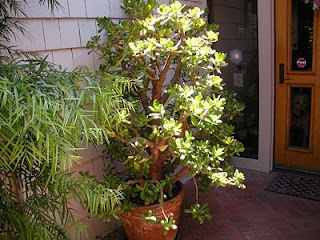
Weeping willow trees have always been magical to me. In the yard where I grew up, every spring I would excitedly await the blooming of the golden green drooping flowers that cascaded like magical jewels from the pendulous branches of my "fairy tree". It was like a secret world under that tree. When I grew up and had my own house, there was a weeping willow planted next to the driveway that made a grand focal point in our yard.
As everyone knows who has experience with this tree, they are messy and full of bugs in the summer. The roots are invasive and often sit partly above ground, ready to trip you when you walk upon them. There are green worms that live among the slim leaves, and the tree is constantly dropping thin, wiry twigs that always need raking up. My husband hated our tree in Connecticut, it was so messy. He always threatened to cut it down, but never did. Until one day.
I drove down the street towards home, and as I made the turn into the driveway, SOMETHING WAS MISSING. In total shock, I saw the tree had been murdered. Not one trace of it remained, not one stray twig or leaf. The crime scene was clean. I sat in my car and sobbed. I've since forgiven him for that horrible affront to my willow sensitivity, and have to say, even though I missed that beautiful, graceful tree, I didn't mind not having to clean up after it.
Fast forward many years. My new garden needs something sort of tall, but open-structured. We have a wide-open view of the valley below, with a peek-a-boo view of the Pacific Ocean. This gives the yard less of a claustrophobic feel (mind you, the width of the back yard is about 50 feet), and opens up to this wide open, nicely planted hillside. The hillside is a common landscape area, maintained by the community landscapers, and is planted with lantana, honeysuckle, and various other colorful, low maintenance plants and shrubs. I wanted to make a seamless transition from the yard to the open area. Replacing the ugly wood-framed, termite-infested cloudy plexiglass panelled back wall with glass panels and aluminum posts gave us an unobstructed view.

Recalling my love for willows, I knew a real willow would not fit in that space. On a trip to Tree of Life nursery, I saw what I thought would be perfect: Fern of the Desert (Lysiloma). There was one planted in the center of the nursery. I loved its twisty branches, and it seemed that it would work. The name was so charming, and captured the mood I wanted to convey. However, more research was called for, and I came up with another idea that thought would work better. It had to be fast growing, have an open, see-through structure, and had to provide some food and/or shelter for my wild pets. In my search for Lysiloma, I found another tree that I liked even better - Chilopsis.
Desert Willow grows quickly in the first few years, eventually getting to be about 20 feet tall. In the spring and summer, scented catalpa-like tubular flowers in pink, white, and lavender bloom, drawing in the hummingbirds. It is deciduous, but not messy, and the willow-like leaves decompose easily and quickly in the garden. I didn't sweep one leaf when they fell last winter, and just let them crumble into the mulch, and feed the tree. It likes light to moderate water, full sun, is hardy to below zero. Once it gets bigger, hummingbirds will make it their summer home.


Knowing it grew fast, and not having the space to dig a big hole, I got one that was about 2 feet tall in a 5 gallon container. My friend, the woman who helped me design the garden, was sort of laughing that "this is a tree?" but it is growing lushly and quickly. There were a few flowers already this year, and I can't wait to see it grow taller. It can be pruned to resemble a willow, and it's good to know it's not messy!





























